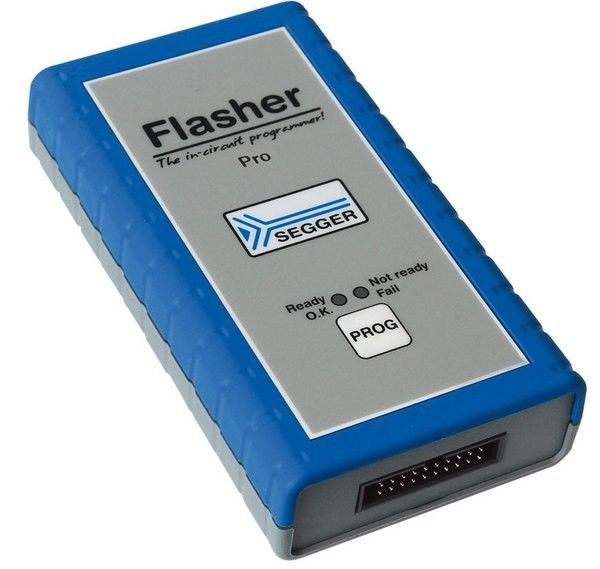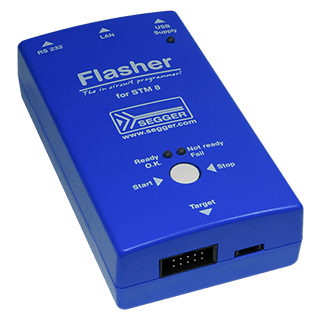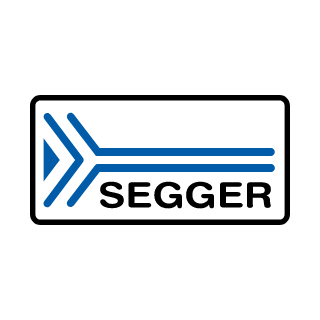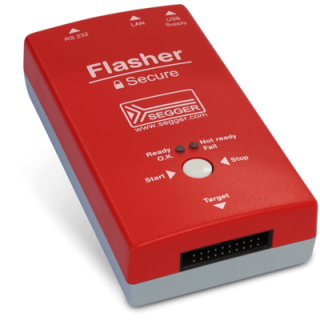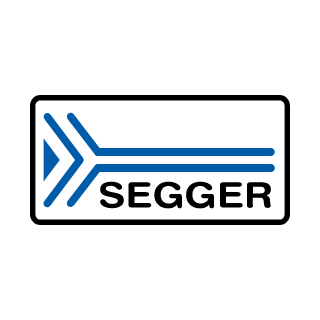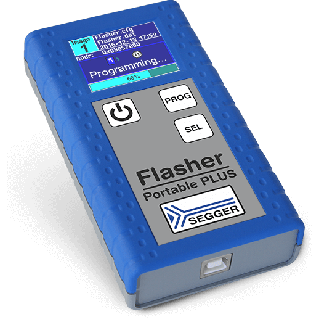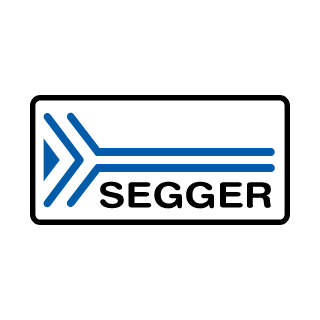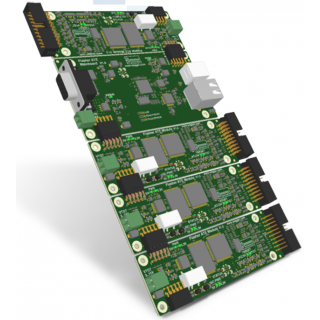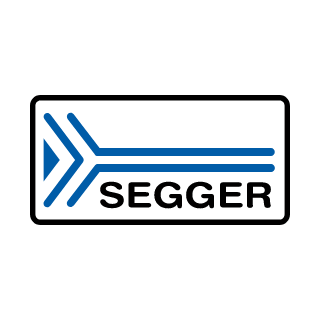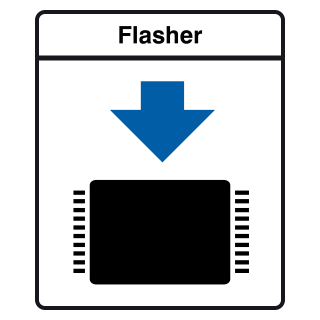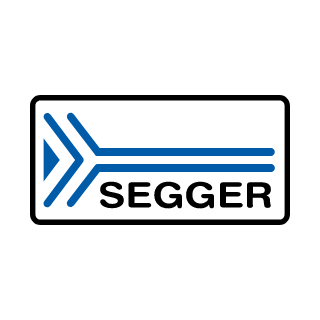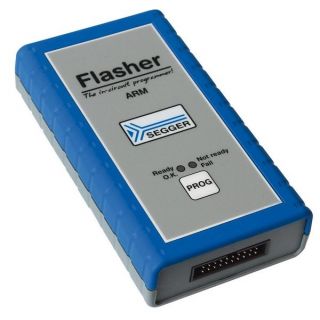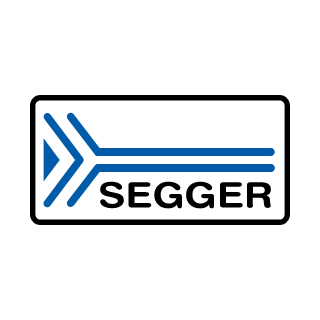We use cookies to make your experience better. To comply with the new e-Privacy directive, we need to ask for your consent to set the cookies. Learn more.
Flasher PRO is a programming tool for microcontrollers with on-chip or external Flash memory and ARM, RX or PPC core. Flasher PRO is designed for programming flash targets with the J-Flash software or stand-alone. Flasher PRO connects via USB, Ethernet or via RS232 interface to a PC, running Microsoft Windows 2000, Windows XP, Windows 2003, Windows Vista, Windows 7, Windows 8 or Windows 10 and has a built-in 20-pin JTAG connector, which is compatible with the standard 20-pin connector defined by ARM.
Flasher can be used for programming flash targets with the J-Flash software or stand-alone.
Setting up Flasher for the first use
In order to use Flasher for the first time you need to install the Flasher related software and documentation pack which, among others, includes the J-Flash software and connect Flasher to the host PC via USB.
Power-on sequence
In general, Flasher should be powered on before connecting it with the target device. That means you should first connect Flasher with the host system via USB / RS232 and then connect Flasher with the target device via JTAG. Power-on the device after you connected Flasher to it. If you use Flasher in stand-alone mode, just power-on Flasher via external power supply.
Verifying target device connection with J-Link Commander
If the USB driver is working properly and your Flasher is connected with the host system, you may connect Flasher to your target hardware. Then start the J-Link command line tool JLink.exe, which should now display the normal Flasher related information and in addition to that it should report that it found a JTAG target and the target’s core ID. The screenshot shows the output of JLink.exe. As can be seen, it reports a Flasher with 3 JTAG devices connected.
Verifying target device connection with J-Flash
Another way to verify the target connection is to connect to the target using J-Flash. To connect to the target with J-Flash you have to choose an appropriate project file for the target first. After opening the project file choose Target --> Connect from the menu to connect to the target.
J-Flash is a software running on Windows (Windows 2000 or later) systems and enables you to program your flash EEPROM devices via the JTAG connector on your target system.
J-Flash works with any device/core that is supported by J-Link and supports all common external flashes, as well as the programming of internal flash of ARM microcontrollers. It allows you to erase, fill, program, blank check, upload flash content, and view memory functions of the software with your flash devices.
In order to setting up Flasher for the "stand-alone mode" it has to be in "J-Link mode". When the correct connection of Flasher to the host PC is verified start the J-Flash software. For more information about the general setup sequence to prepare Flasher for stand-alone mode, please refer to the Flasher User's Guide (UM08022).
Progress and result of an operation is indicated by Flasher's LEDs:
| Status of LED | Meaning |
| GREEN, high frequency flashing (10 Hz) | Enumerating Flasher. |
| GREEN, slow blinking (1 Hz) | Programming. |
| GREEN | Programming operation successful / Ready. |
| RED | Programming operation failed. |
Flasher can be remote controlled by automated testers without the need of a connection to PC and Flasher's PC program. Therefore Flasher is equipped with additional hardware control functions which are connected to the SUBD9 male connector, normally used as RS232 interface to PC. The following diagrams show the internal remote control circuitry of Flasher:
| Pin | Function | Description |
|---|---|---|
| 1 | START | A positive pulse of any voltage between 5V and 30V with duration of min. 30 ms starts automatic programming (typically erase / program / verify) on falling edge of pulse. |
| 4 | BUSY | As soon as Auto-Function is started, BUSY becomes active, which means that transistor is switched OFF. |
| 5 | GND | Common Signal ground. |
| 7 | OK | This output reflects result of last action. It is valid after BUSY turned back to passive state. The output transistor is switched ON to reflect OK state. |
Flasher PRO supports a wide range of CPU cores and an even wider range of different devices from various vendors. On this page, an overview of all supported CPU cores as well as devices for which flash programming is supported, is given.
The following CPU cores are supported by Flasher PRO:
|
|
|
Any microcontroller, MPU, SoC with a supported CPU core with its debug interface accessible, is supported and can be controlled by Flasher PRO.
1 - Supported via Universal Flash Loader.
2 - No Flasher stand-alone support yet. Currently, flash programming is available via PC based J-Flash software only.
List of Supported Devices for Flash Programming
The following list gives an overview about which devices are known by Flasher PRO and are available for flash programming. In case of doubt, please feel free to get in touch with SEGGER.
The list below is always valid for the latest version (highest version number) of the J-Link/Flasher software package. This may be a release (even version number) or beta version (odd version number), since support for some devices is usually added in a beta phase first.
Supported SPI flashes
The Flasher PRO does also support download into SPIFI (SPI Flash Interface) flashes in case they are memory mapped readable through the CPU (called SPIFI support on most targets).
Moreover, utilities like J-Flash SPI also support direct programming of SPI flashes without any CPU in between.
The following SPI flashes are currently supported by the Flasher PRO (J-Link software package):
Universal Flash Loader
Besides programming the flash memory via the debug interface (JTAG), there are some devices which are programmed via a device-specific programming interface. These interfaces can be supported by the Universal Flash Loader, a feature for the Flasher PRO and the Flasher Portable PLUS. The Universal Flash Loader supports the serial programming interface of the Renesas RL78 device family, based on a 16 bit microcontroller including over 1000 devices.
Universal Flash Loader Configurator
The Universal Flash Loader Configurator is a software utility to prepare the Flasher for programming. It includes a device database and a comfortable user interface for configuration.
The configuration and data files can be directly downloaded via USB to a connected Flasher PRO or Flasher Portable PLUS. The utility is able to save the configuration settings into a project file for later use, so the image file can easily be upgraded.
Manual Setup
Besides using the Universal Flash Loader Configurator, it is also possible to manually create or edit a configuration. This might be of interest for very new devices which are not yet known to the configuration utility. The configuration files for the Universal Flash Loader are in the human readable ini file format. For a detailed description of the individual properties please refer to the Flasher User's Guide (UM08022).
List of Supported Devices for Flash Programming
The following list gives an overview about which devices are available for flash programming using the Universal Flash Loader. In case of doubt, please feel free to get in touch with SEGGER.
The list below is always valid for the latest version (highest version number) of the J-Link/Flasher software package. This may be a release (even version number) or beta version (odd version number), since support for some devices is usually added in a beta phase first.
Target Connection
Flasher RL78 adapter
SEGGER offers an adapter to connect the Flasher to these evaluation boards. There are special adapters to use with the Universal Flash Loader. RL78 evaluation boards typically come with a 14-pin connector.
Flasher RL78 adapter connected to Flasher PRO
Example: Flasher RL78 adapter connected to Flasher PRO. The adapter can be used with Flasher Portable PLUS as well.
Target Interfaces
Since Flasher PRO is compatible to J-Link it also supports the same target interfaces. Currently the following target interfaces are supported:
- JTAG
- SWD
For more information about the target interfaces please refer to J-Link - Interface description. Please note that Flasher PRO currently does not support SWO.
JTAG Speed
There are basically three types of speed settings:
- Fixed JTAG speed
- Automatic JTAG speed
- Adaptive clocking
Fixed JTAG Speed
The target is clocked at a fixed clock speed. The maximum JTAG speed the target can handle depends on the target itself. In general ARM cores without JTAG synchronization logic (such as ARM7-TDMI) can handle JTAG speeds up to the CPU speed, ARM cores with JTAG synchronization logic (such as ARM7-TDMI-S, ARM946E-S, ARM966EJ-S) can handle JTAG speeds up to 1/6 of the CPU speed. JTAG speeds of more than 10 MHz are not recommended.
Automatic JTAG Speed
Selects the maximum JTAG speed handled by the TAP controller.
NOTE: On ARM cores without synchronization logic, this may not work reliably, since the CPU core may be clocked slower than the maximum JTAG speed.
Adaptive Clocking
If the target provides the RTCK signal, select the adaptive clocking function to synchronize the clock to the processor clock outside the core. This ensures there are no synchronization problems over the JTAG interface.
NOTE: If you use the adaptive clocking feature, transmission delays, gate delays, and synchronization requirements result in a lower maximum clock frequency than with non-adaptive clocking. Do not use adaptive clocking unless it is required by the hardware design.
| Power Supply | USB powered, 100mA for Flasher PRO. 500 mA if target is powered by Flasher PRO | ||||
|---|---|---|---|---|---|
| USB Host Interface | USB 2.0 | ||||
| RS232 Host Interface | RS232 9-pin | ||||
| Target Interface | JTAG 20-pin (14-pin adapter available) | ||||
| Max. target cable length | Recommended (delivered): 20cm (8") Max. 2m (6.5") allowed but might reduce max. target interface speed. | ||||
| Serial Transfer Rate between Flasher PRO and Target | Max. target interface (JTAG, ...) speed: 15MHz | ||||
| Supported Target Voltage | 1.2 - 5V | ||||
| Current drawn from target voltage sense pin (VTRef) | < 25µA | ||||
| Target supply voltage | 5V | ||||
| Target supply current | Max. 400mA | ||||
| Operating Temperature | + 5 °C ... + 60 °C | ||||
| Storage Temperature | - 20 °C ... + 65 °C | ||||
| Relative Humidity (non-condensing) | < 90% rH | ||||
| Size (without cables) | 121mm x 66mmx 30mm | ||||
| Weight (without cables) | 120g | ||||
| Supported OS | Microsoft Windows 2000 Microsoft Windows XP Microsoft Windows XP x64 Microsoft Windows 2003 Microsoft Windows 2003 x64 Microsoft Windows Vista Microsoft Windows Vista x64 Microsoft Windows 7 Microsoft Windows 7 x64 Microsoft Windows 8 Microsoft Windows 8 x64 Microsoft Windows 10 Microsoft Windows 10 x64 | ||||
Tecnologix offers support which is directly handled by development team. Do not hesitate to get in touch with our experts.
Just ask here



